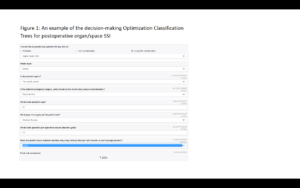Predicting the Risk of Surgical Site Infection Using Interactive and Machine-Learning Optimal Classification Trees
Author(s):
Dimitris Bertsimas; Jack Dunn; George Velmahos; Haytham Kaafarani
Background:
Most risk assessment tools presume that the impact of risk factors is linear and simply cumulative. Using novel machine-learning techniques, we aimed to design an interactive calculator to predict the risk of surgical site infection (SSI) for Emergency Surgery (ES).
Hypothesis:
Not applicable
Methods:
All ES patients in the ACS-NSQIP 2007-2013 database were included. Optimal Classification Trees (OCT) were leveraged to train machine-learning algorithms to predict SSI. Unlike classic heuristics (e.g. logistic regression), OCT is adaptive and reboots itself with each variable thus accounting for non-linear interactions among variables. An application was then designed as the algorithms’ interactive and user-friendly interface. We tested the ability of our application and models to predict SSI in a separate 2014 NSQIP validation cohort.
Results:
Out of 382,960 ES patients, comprehensive decision-making algorithms predicting superficial, deep incisional and organ/space SSIs were derived where the provider’s answer to a question interactively dictates the subsequent question [Figure 1]. For any specific patient, the number of questions (thus tree branching/variables) needed to predict SSIs ranged from 4 to 10. The c-statistics of the models predicting superficial, deep incisional and organ/space SSIs in the validation cohort were 0.68, 0.75, and 0.79, respectively.

Conclusions:
We thus reveal a novel, evidence-based, adaptive and user-friendly calculator capable of accurately predicting the risk of SSI in ES. Such a tool might prove useful for bedside preoperative counseling of ES patients and families, as well as for quality benchmarking of ES care.
